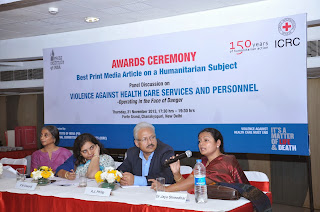Journalists from The Hindu, The Week, Greater Kashmir bag awards – it’s the age of the young reporter
Journalists
of The Hindu, The Week and the Greater Kashmir newspaper shared the
first three prizes respectively for the competition for the best print article on
the theme, Violence against Health Care Services and Personnel - Operating in the Face of Danger organised by
the Press Institute of India and the International Committee of the Red Cross.
Anumeha Yadav of The Hindu won the first prize, Mini Thomas of The Week and Imran Muzaffar of Greater
Kashmir shared jointly the second prize. The winners were chosen from some
30 published articles short-listed from nearly 40 entries received.
I was delighted to present the awards to the
winners at a function in New Delhi
earlier this week, with Mary Werntz, head of Regional Delegation of the
International Committee of the Red Cross (ICRC). The awards, in its sixth year,
are meant to recognise articles highlighting a humanitarian concern and
published in an Indian national or regional newspaper or magazine. The jury
comprised Pamela Philipose, director and editor-in-chief of Women's Features
Service, A.J. Phillip, senior journalist, Dr
Jaya Shreedhar, founding member of the Centre for Security Analysis, and P.N. Vasanti, director of the Centre for Media Studies.
I thought the evening belonged to the Young Indian Reporter.
Today, the reporter has to brave many odds to get a story in print or on
television or online. The situation is of course not as bad as it is in Mali , for
example, where Radio France Internationale journalists Ghislaine Dupont and Claude Verlon were kidnapped on November 2
and killed. They were on special assignment two weeks ahead of
legislative elections in the country, when armed men abducted them. In Ethiopia , five
journalists were imprisoned under the country’s anti-terrorism laws and world
media organiosations have called for their unconditional release. In Kenya , a
proposed new media law risks imposing severe financial sanctions against
journalists, publishers and broadcasters for breaching a code of conduct, and
could even bar journalists from working.
Compared to all that, the media in India has far
greater freedom; perhaps too much of it. However, reporting from Kashmir or the Northeast or the Naxalite-Maoist-insurgency-affected
central belt is not easy. And then there are other dangers, such as the one young
Tarun Sehrawat faced – deep in India ’s
heartland. He died due to cerebral malaria and other illnesses. A young
reporter so filled with the passion of bringing stories to the fore, his life
snuffed out in days. The Tehelka story that is doing the rounds now is an
example of yet another kind of pressure women in journalism face.
So, despite all this, when young reporters risk their lives
to bring stories to light, we must salute them. Their efforts also symbolise all
that is good in journalism – honesty, hard work, truth-telling. When an Anumeha
Yadav reporting from Chhattisgarh’s interior, or Mini Thomas from Karnataka’s
or Imran Muzaffar from Kashmir ’s want their
voice to be heard, they echo from the cliffs and mountain tops and valleys.
As I presented the awards, I felt humbled. Imran so badly
wanted to speak about the conditions in which he operated but time constraints did
not allow that. Now I just wish we had given him some time.
Pictures show the award winners (Anumeha in the centre); Dr
Jaya making a point at the panel discussion; me with the others (Pamela, sadly, is out
of the picture) for a photo-op, and later with a group of journalists from Kashmir and Surnder Oberoi, ICRC’s communications head
(extreme right).




Comments